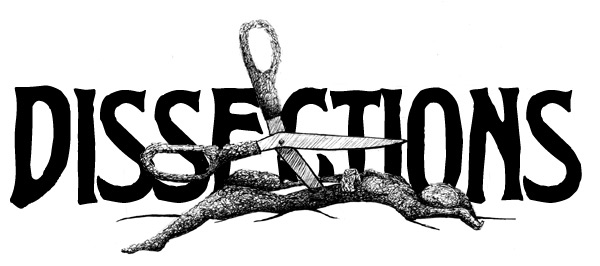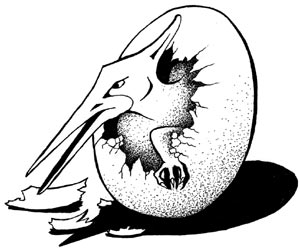[an error occurred while processing this directive]



Horror in Academia: Tales from the Literary Crypt
Rhonda Brock-Servais
The End
Picture a typical college classroom: the desks have been moved into
a U and are filled with students – mostly 20, mostly white,
mostly female, mostly from the South, as is typical of my school.
One stands at a whiteboard, jiggling a marker in her hand. In one
desk sits a dignified woman of perhaps 60, graying hair, a dark skirt
and jacket, and a string of pearls, taking notes on a yellow legal
pad. Moving around within the U is me, the teacher, 30-some years
old at the time. I am being observed as part of my yearly tenure evaluation,
but I’m not worried. I’m proud of my classroom and my
ability to get the students talking.
In this class we’ve just finished several weeks on the vampire archetype and it’s time to move on. We’re starting a new archetype on this day – the werewolf. We’re brainstorming what we know and what we think we know, thus the student at the board taking notes as the students throw out ideas – things they’ve picked up from pop culture, movies mostly. We talk a bit about folklore and history after someone mentions the film The Brotherhood of the Wolf. The note-taker scribbles quickly, her handwriting getting messier with each word, but still better than mine.
In a quiet gap I ask, ‘What about sex? Does anybody associate the werewolf with sexuality? Not nice, I’m going to seduce you and drink your blood sex.’ Here I take two fingers and tap myself on the neck. ‘But really raw, tooth and claw, I’m going to rip you up, animal-type sex.’
Now I make my hands into claws and rake the air in a crouch. Spinning on my heel, I stop short and look right into the face of the dignified lady in pearls. Her face is a mask, absolutely, carefully still and unreadable.
The Beginning
In the Spring of my first tenure-track year, I proposed a course on
Horror for the upcoming fall term. The department had a 300-level
special topics designation that was mostly used for mythology, Southern
writers and detective fiction. The chair said I could propose whatever
I liked as long as I thought it would be of interest to students.
This type of course was often taken by students outside of the department
to fulfill an upper division humanities requirement. So, I made my
proposal on the spring course request form without a second thought,
alongside the Children’s Literature courses I was required to
teach. Of course, all my colleagues respected me and would understand
that this (admittedly somewhat unconventional subject) was innately
worthy with the added bonus that students would flock to the class.
Where was the downside? Who wouldn’t want a horror class added
to the schedule?
Well, it seems that the curriculum committee didn’t want it on the schedule. Or, perhaps they did. At any rate, the next thing I knew, they wanted to speak to me, and I was invited to their regular meeting. I had been called before this august group before; at the time, I taught Children’s and Young Adult literature classes for at least three-quarters of my load. As is usual for classes taught by one department (English) but required by another (Education), there is some tension over content. I had already explained to them how the field had changed since 1973 and the difference between content and pedagogy courses. I also had successfully made the argument that the Education department should not get to choose the texts that were used. The general consensus was that my knowledge of the field and my independence were positive traits and, further, if the department was to be responsible for this course, it really needed to be our own. Yeah for the spunky gal and her new-fangled ideas!
The Middle
At the meeting, the Lady in Pearls (who served on both the Curriculum
Committee and the Promotion/Tenure Committee) began by asking, “Did
you mean to propose a course on the Gothic?” My ears heard a
“Dear” at the end of the question. No, I responded, I
did not, although I thought perhaps we’d look at some traditional
gothic material – maybe The Castle of Otranto or The
Monk. If I didn’t mean gothic, then the committee wasn’t
entirely sure what I was proposing – surely not Stephen King
(I didn’t mention that Stephen King once won the O. Henry award).
They would be much more comfortable if I could provide them with a
reading list. Could I do that by the end of the week (it was Wednesday)?
Not to rush me, but if I was serious about this, it needed to be done
in a timely fashion as the schedule was on a schedule.
My proposal was made in innocence, but I now realized that it was also done in ignorance. Thus, I worked to overcome that. In making my reading list, I thought about our major (seven period courses of British and American canonical literature, not, emphatically NOT, surveys). I looked back through the types of special topics courses that had been taught over the last few years (Mythology, Arthurian Literature, The Victorian Serial Novel). I also considered my own place in the department as the Kiddie Lit person. Perhaps my spunk with regard to one topic was not appropriate with another. Perhaps I really was the second-class citizen all those other Kiddie Lit people at all those other schools were. Maybe I wasn’t as special as I thought I was. On Friday morning I sent out a list titled “Literary Horror.” It included, among other things, The Castle of Otranto, Frankenstein, Dracula, Strange Case of Dr. Jekyll and Mr. Hyde, The Turn of the Screw, some of Poe’s works, some of Lovecraft’s, a novel by Peter Straub, as well as Hartwell’s anthology The Dark Descent.
Early the following week a flurry of e-mails arrived. Who was David Hartwell? Why was that anthology so special? Who was the Straub guy? How would I tie my material into our core classes? What sort of secondary material would I be presenting? Could I find enough material of literary quality to fill a course? Was I planning on incorporating any film? What sorts of assignments was I thinking about?
Here’s how I didn’t answer: Look him up! Check out the book online – amazon.com has a table of contents. Look up Straub, too, while you’re at it. Does the material need to be tied to the core classes if the audience is primarily non-majors? I thought I would present the secondary material I have listed there: Poe and Lovecraft to start. Since when do we do criticism with non-majors, anyway? “Literary” horror – get it? I worked out that title just for you folks. James, Shelly, Stevenson, and Poe all sneak into other classes. They can’t all be taught together? Do you see any films listed? Well, that answers that. Assignments would be generated from the reading list and of the usual sort. How the heck do I know? You asked for a reading list. Oh, and, did you ask for a reading list from the guy who taught the Victorian Serial, a genre not necessarily known for its literary quality.
The committee, the Lady in Pearls informed me, would be more comfortable if they had a full syllabus to look at. Oh, and as the schedule was due quite soon, perhaps I should think about doing another general education Themes in British Literature course; she had heard good things about the one I was teaching this term. Why stray from the classics?
My complete syllabus, completed in record time, netted me another meeting with the full committee. Now their questions were of a more philosophical nature and ones that people who are reading this essay have heard before: Why would I be interested in such terrible things, especially as the world was already so ugly? Wasn’t I afraid of upsetting the students, giving them nightmares, as it were? Wasn’t I afraid of desensitizing them to violence? Or perhaps putting ideas in the head of a student who was already unstable? Wouldn’t this class just appeal to the basest parts of humankind?
Why would I want to teach material that is stupid, gross, immoral and distasteful? OK, no one actually articulated that last question, but it was there.
Finally, my patience, persistence, patience, professionalism…and patience…won the day. Literary Horror was awarded a rarified spot on the fall schedule – my second Themes in British Literature would just have to wait; I had a course to prepare. No, hang on, no I didn’t. It was already done thanks to the Lady in Pearls.
A New Beginning
The second incarnation of Literary Horror was on the schedule for
Fall 2007; this time it had been approved without comment (perhaps
I should mention the dignified Lady in Pearls no long sat on the curriculum
committee).
On April 16, 2007, 32 students were shot at Virginia Tech by a young
man who had an interest in violent movies, videogames, and books.
Was this really an appropriate time to teach such a class, my new
chair asked….